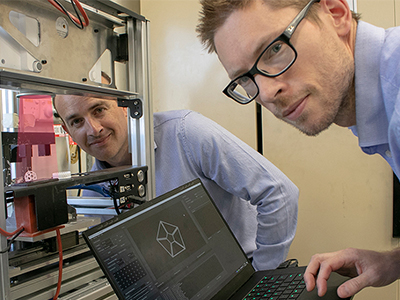Transformative energetic materials on the horizon

Defence scientist Andrew Hart anticipates that within the next decade or so, advances in energetic materials coupled with cutting edge manufacturing technology that can exploit those materials, will see the introduction into service of new classes of weapons. These weapons are set to offer disruptive performance gains and a level of operational flexibility that is unachievable at the moment.
To position the ADF and Australian defence industry to take full advantage of those technical benefits, DST has initiated the Transformative Energetics Research Program. It has three key planks – nano-scale energetic materials, resonant acoustic mixing (RAM) and 3D printing of energetics.
Tiny particles, big potential
Nano-particles typically display properties that differ markedly from larger forms of the same material. When compared with more traditional micron-sized energetic material particles, nano-scale energetic particles give rise to munitions that offer enhanced energy output with reduced sensitivity. This could lead to design options such as lighter weapons, additional space for other weapon components and the use of explosive ordnance in previously inaccessible extreme operational environments.
RAM is a relatively new technique that uses low-frequency, high-intensity vibration to blend highly viscous materials rapidly and effectively. It’s a contactless mixing technique, there are no moving parts in contact with the energetic material and this confers process safety benefits. “The mixing ability affords us the potential to now incorporate a higher proportion of high energy-density solids, including hard to process materials such as nano-energetics, into our materials,” Hart explains. “This confers additional energy into the system, beyond that which has been possible historically with conventional processing technology.”
3D printing of energetic materials
Hart, a chemical engineer, has observed a significant increase in interest around the world in the 3D printing of energetic materials over the past 4-5 years with researchers examining all classes from gun and rocket propellants to pyrotechnics to high explosives. “There is such a strong interest because the performance gains that stand to be unlocked are astounding,” he says. “3D printing lets us create complex, truly three dimensional structures that give us superior control over the nature of the energy release. In pyrotechnics we can better tailor spectral output, for example. With high explosives improved safety and better detonation characteristics are possible, opening the door to concepts such as dial-a-yield warheads.”
The smaller manufacturing footprint required by 3D printing, and the agile nature of the same, means energetic materials might ultimately be produced, for example, on demand in theatre, bringing to bear significant strategic and logistic advantages. To date, a focus at DST has been on the possibility of printing large calibre gun propellants, because it’s here that some of the greatest performance and logistic advantages can be unlocked.
The Transformative Energetics program is broad in scope and highly multi-disciplinary in nature, thus necessitating a collaborative approach in order to expedite the research and to position defence industry to adopt the manufacturing technologies once matured. Hart and colleagues are teaming with industry and academia in a multi-year Cooperative Research Centre project looking at the 3D printing of energetics, have industry alliances in the area of RAM, and collaborate with Defence government partners across all facets of DST’s Transformative Energetics program.

